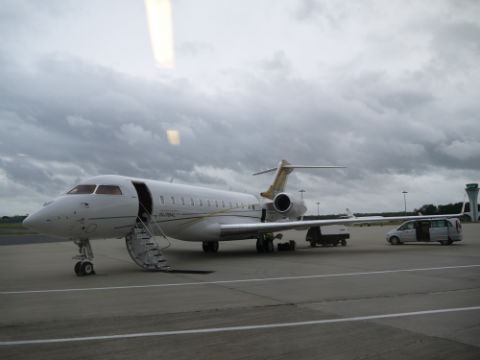Last week, I got to fly to Geneva in Bombardier’s latest plane, the Global 6000. Check out my review on my Forbes column.
Geneva to Palma by Piper
It was a clear blue sky over a clear blue sea, and we were cruising at 130kts, Palma de Mallorca beckoning, and all was well with the world.
We had departed from Montpellier Candillargues an hour earlier, our Piper Dakota fully fueled with 72 gallons of Avgas, yellow life vests over us, and a life raft that was somewhat uselessly stored in the luggage compartment. We had been handed over from Marseille Information to Barcelona, and for a while there was only silence on the radio, and we were contemplating the beautiful scenery and how incredibly privileged we were.
Geneva (LSGG)
Welcome to Geneva airport. Local pilot, Vincent (author of the PlasticPilot blog) gives us the low-down. The main concrete runway is just huge, 4’000 meters long, but also very busy. All single engine VFR have use the grass strip which runs parallely on the north-west side. The grass strip is short (520 meters LDA) and there are trees on the 05 climb-out trajectory.
[post-geocode zoom=”14″]
If you need main runway for performance reasons, expect delays. A good thing is to check the ATIS before departure (+41 22 417 40 81). If the grass runway is closed, expect delays. Grass runway can also be “restricted” which means that the grass taxiway can’t be used, and planes shall enter and leave grass runway at its end.
There are four VRPs (N, S, E and W) which are easy to spot. Flying VFR you’ll have to be below airspace Charlie of TMA, flying at 3’500ft. ATC speaks good english, but don’t expect too much help regarding orientation. Coming from South or East, the controllers will clear you to cross the main runway at 3’000ft to join the grass runway’s pattern. Doing so give you a breathtaking overfly of the city and the famous “Jet d’eau”.
During winter season (Christmas to Easter) the airport is really busy, and all private operations are PPR, via a web-based slot allocation system (www.gva.ch). All details are published via NOTAMs.
All IFR operation take place on the concrete runway. To avoid slots, it is better to file IFR flight plans at least 3 hours in advance, preferably the day before. On arrival high performance singles are preferred, and you can expect the controller to ask you “What will be your speed on final ?” Answering “160kts to 2 miles” is always welcome. “145 to 4 miles” goes, and “90kts” will certainly make the controller vector you parallel to the ILS.
The IFR departures routes require a climb gradient of 7% to 7’000ft, because of surrounding high ground. Departure routes towards north require a climb to 7’000 ft before turn. Departure towards south is not possible without turbo / pressurised aircraft as the minimal FL over the alps is FL160.
The general aviation terminal in on the north side. There is a fuel pump for AVGAS and trucks for Jet-A1. Remember that Switzerland is not yet in the European Union, so you will need customs clearance. Both Swiss and French customs are present, making flights to any french airport possible, no need for a french airport of entry.
Bus, taxi and train (best way to go to city center) are available… on the south side. To go there, ask for a shuttle on the north side. A taxi ride to the city is roughly 50 CHF, and a public transport ticket for one hour will cost you 3 CHF…
All possible tourist information can be found in the main terminal waiting hall.
Night VFR is PPR, and the airport closes to private traffic at 2200 LT. No exceptions.

